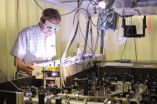Vampire jumping spiders identify victims by their antennae
2012-06-08
(Press-News.org) Evarcha culicivora jumping spiders, also known as vampire spiders, are picky eaters by any standards. Explaining that the arachnid's environment is swamped with insects, Ximena Nelson from the University of Canterbury, New Zealand, says, 'You can see from the diet when you find them in the field that there is a high number of mosquitoes in what they eat'. And when Robert Jackson investigated their diet further, he found that the spiders were even more selective. The delicacy that E. culicivora prize above all others is female blood-fed Anopheles mosquitoes, which puzzled Nelson. How could these picky spiders pick out blood-engorged Anopheles mosquitoes from the swarms of similarly sized insects infesting the area? Nelson and Jackson decided to do some jumping spider psychology to find out how the arachnids pick out blood-fed female Anopheles mosquitoes from the crowd and they publish their discovery that the spiders identify the females by their antennae in The Journal of Experimental Biology at http://jeb.biologists.org.
According to Nelson, identifying Anopheles mosquitoes (males and females) is quite straightforward. 'The bodies of Anopheles mosquitoes rest on a 45deg angle from the substrate but most others rest parallel', she explains. But what other distinguishing features could the famished spiders use when selecting the females specifically? 'Obviously, blood-fed females have an engorged red abdomen and the other difference that comes to mind between males and females is the antennae', says Nelson. Explaining that male Anopheles have luxuriant fluffy antennae, while the female's are less elaborate, Nelson decided to see which mosquito features E. culicivora fixate on.
Collecting male and female Anopheles and Culex mosquitoes at the International Centre for Insect Physiology and Ecology in Kenya, Nelson, Godfrey Sune and other helpers painstakingly constructed hybrid mosquitoes. Combining the head and thorax of one insect with the abdomen of another, the team was able to produce Frankenstein mosquitoes with blood-engorged female abdomens and male antennae, slender male abdomens and female antennae, and every other combination in between. Then, they mounted the hybrid mosquitoes in their correct postures and tested the spiders' preferences.
'The great thing about jumping spiders is they're very decisive', recalls Nelson, who could clearly see that the spiders preferred intact blood-engorged females over everything else, even females engorged with transparent sugar solution. And, when Nelson offered the spiders the choice between a Frankenstein female (made from the head and thorax of one female fused to the blood-engorged abdomen of a second female) and a hybrid constructed from a male head-and-thorax and a blood-engorged female abdomen, the spiders usually selected the hybrid with the female antennae, even though both hybrids were packed with blood. Also, when she tempted the spiders with animated simulations of blood-engorged mosquitoes with either male or female antennae, the spiders consistently pounced on the simulated female.
The spiders weren't just picking out Anopheles mosquitoes with abdomens full of blood; they were able to identify the mosquitoes by their antennae. 'The thing that really amazed me is that I couldn't actually see the difference when I was looking at the screen', recalls Nelson. Even when she got down to the spider's level, the mosquitoes were too small for Nelson to discern the insects' minute antennae.
Having found that picky E. culicivora can identify the tastiest mosquitoes by their antennae, Nelson is curious to find out how they process this visual information: whether they assess all of the mosquito's characteristics simultaneously or systematically tick features off a check list before deciding to attack. Nelson also adds that she is baffled by how the spider's tiny brain processes all of the sensory information that they must handle when making their decision.
INFORMATION:
IF REPORTING ON THIS STORY, PLEASE MENTION THE JOURNAL OF EXPERIMENTAL BIOLOGY AS THE SOURCE AND, IF REPORTING ONLINE, PLEASE CARRY A LINK TO: http://jeb.biologists.org/content/215/13/2255.abstract
REFERENCE: Nelson, X. J. and Jackson, R. R. (2012). The discerning predator: decision rules underlying prey classification by a mosquito-eating jumping spider. J. Exp. Biol. 215, 2255-2261.
This article is posted on this site to give advance access to other authorised media who may wish to report on this story. Full attribution is required, and if reporting online a link to jeb.biologists.com is also required. The story posted here is COPYRIGHTED. Therefore advance permission is required before any and every reproduction of each article in full. PLEASE CONTACT permissions@biologists.com
THIS ARTICLE IS EMBARGOED UNTIL THURSDAY, 7 June 2012, 00.15 HRS EDT (04:15 HRS GMT) 05:15 HRS BST.
END
ELSE PRESS RELEASES FROM THIS DATE:
2012-06-08
In a critical step that may lead to more effective HIV treatments, Harvard scientists have found pre-existing mutations in a small number of HIV patients. These mutations can cause the virus to develop resistance to the drugs used to slow its progression.
The finding is particularly important because, while researchers have long known HIV can develop resistance to some drugs, it was not understood whether the virus relied on pre-existing mutations to develop resistance, or if it waits for those mutations to occur. By shedding new light on how resistance evolves, the study, ...
2012-06-08
SEATTLE – In exploring the genetics of mitochondria – the powerhouse of the cell – researchers at Fred Hutchinson Cancer Research Center have stumbled upon a finding that challenges previously held beliefs about the role of mutations in cancer development.
For the first time, researchers have found that the number of new mutations are significantly lower in cancers than in normal cells.
"This is completely opposite of what we see in nuclear DNA, which has an increased overall mutation burden in cancer," said cancer geneticist Jason Bielas, Ph.D., whose findings are published ...
2012-06-08
SAN FRANCISCO, CA—June 7, 2012—Scientists at the Gladstone Institutes have for the first time transformed skin cells—with a single genetic factor—into cells that develop on their own into an interconnected, functional network of brain cells. The research offers new hope in the fight against many neurological conditions because scientists expect that such a transformation—or reprogramming—of cells may lead to better models for testing drugs for devastating neurodegenerative conditions such as Alzheimer's disease.
This research comes at a time of renewed focus on Alzheimer's ...
2012-06-08
For the first time, researchers have produced a coherent, laser-like, directed beam of light that simultaneously streams ultraviolet light, X-rays, and all wavelengths in between.
One of the few light sources to successfully produce a coherent beam that includes X-rays, this new technology is the first to do so using a setup that fits on a laboratory table.
An international team of researchers, led by engineers from the NSF Engineering Research Center (ERC) for EUV Science and Technology, reports their findings in the June 8, 2012, issue of Science.
By focusing intense ...
2012-06-08
A breakthrough in laser science was achieved in Vienna: In the labs of the Photonics Institute at the Vienna University of Technology, a new method of producing bright laser pulses at x-ray energies was developed. The radiation covers a broad energy spectrum and can therefore be used for a wide range of applications, from materials science to medicine. Up until now, similar kinds of radiation could only be produced in particle accelerators (synchrotrons), but now a laser laboratory can also achieve this. The new laser technology was presented in the current issue of the ...
2012-06-08
CINCINNATI – Scientists have discovered a new function for a protein that protects cells during injury and could eventually translate into treatment for conditions ranging from cardiovascular disease to Alzheimer's.
Researchers report online June 7 in the journal Cell that a type of protein called thrombospondin activates a protective pathway that prevents heart cell damage in mice undergoing simulated extreme hypertension, cardiac pressure overload and heart attack.
"Our results suggest that medically this protein could be targeted as a way to help people with many ...
2012-06-08
Easy-to-use, inexpensive tests to diagnose infectious diseases are urgently needed in resource-limited countries. A new report based on an American Academy of Microbiology colloquium, "Bringing the Lab to the Patient: Developing Point-of-Care Diagnostics for Resource Limited Settings," describes the challenges inherent in bringing new medical devices and technologies to the areas of the world where they are needed most. Point-of-care diagnostics (POCTs) bypass the need for sophisticated laboratory systems by leveraging new technologies to diagnose infectious diseases and ...
2012-06-08
(PORTLAND, Ore.) —June 07, 2012—Eleven integrated health systems, with more than 16 million members, have combined de-identified data from their electronic health records to form the largest, most comprehensive private-sector diabetes registry in the nation.
According to a new study published today in the Centers for Disease Control and Prevention's Preventing Chronic Disease, the SUPREME-DM DataLink provides a unique and powerful resource to conduct population-based diabetes research and clinical trials.
"The DataLink will allow us to compare more prevention and ...
2012-06-08
There's new hope for development of an antibiotic that can put down a lethal bacteria or superbug linked to the deaths of hundreds of hospital patients around the world.
Researchers from the University of Alberta-based Alberta Glycomics Centre found a chink in the molecular armour of the pathogen Acinetobacter baumannii. The bacteria first appeared in the 1970's and in the last decade it developed a resistance to most antibiotics.
U of A microbiologist Mario Feldman identified a mechanism that allows Acinetobacter baumannii to cover its surface with molecules knows ...
2012-06-08
Berlin, Germany, June 7 2012: Data presented today at EULAR 2012, the Annual Congress of the European League Against Rheumatism, demonstrates that tailoring biologic treatment to individual patients with rheumatoid arthritis (RA) can reduce total costs by €2,595,557 per 272 patients over 3 years (95 percentile range -€2,983,760 to -€2,211,755), whilst increasing effectiveness by an average of 3.67 quality-adjusted life years (QALYs)*. Cost savings were mostly on drug costs.
The Dutch study, which investigated 272 patients with RA starting adalimumab treatment, measured ...
LAST 30 PRESS RELEASES:
[Press-News.org] Vampire jumping spiders identify victims by their antennae


